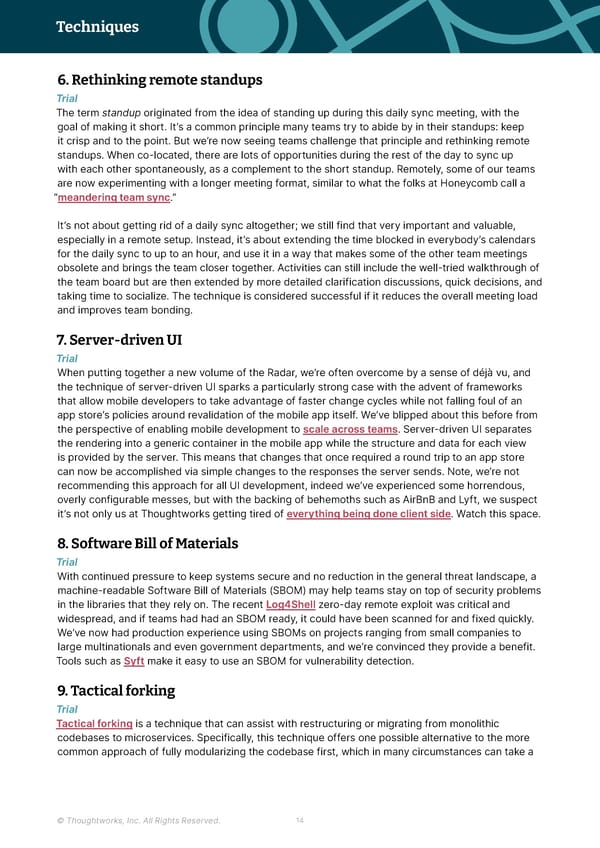Techniques Thoughtworks Technology Radar 6. Rethinking remote standups Trial The term standup originated from the idea of standing up during this daily sync meeting, with the goal of making it short. It’s a common principle many teams try to abide by in their standups: keep it crisp and to the point. But we’re now seeing teams challenge that principle and rethinking remote standups. When co-located, there are lots of opportunities during the rest of the day to sync up with each other spontaneously, as a complement to the short standup. Remotely, some of our teams are now experimenting with a longer meeting format, similar to what the folks at Honeycomb call a “meandering team sync.” It’s not about getting rid of a daily sync altogether; we still find that very important and valuable, especially in a remote setup. Instead, it’s about extending the time blocked in everybody’s calendars for the daily sync to up to an hour, and use it in a way that makes some of the other team meetings obsolete and brings the team closer together. Activities can still include the well-tried walkthrough of the team board but are then extended by more detailed clarification discussions, quick decisions, and taking time to socialize. The technique is considered successful if it reduces the overall meeting load and improves team bonding. 7. Server-driven UI Trial When putting together a new volume of the Radar, we’re often overcome by a sense of déjà vu, and the technique of server-driven UI sparks a particularly strong case with the advent of frameworks that allow mobile developers to take advantage of faster change cycles while not falling foul of an app store’s policies around revalidation of the mobile app itself. We’ve blipped about this before from the perspective of enabling mobile development to scale across teams. Server-driven UI separates the rendering into a generic container in the mobile app while the structure and data for each view is provided by the server. This means that changes that once required a round trip to an app store can now be accomplished via simple changes to the responses the server sends. Note, we’re not recommending this approach for all UI development, indeed we’ve experienced some horrendous, overly configurable messes, but with the backing of behemoths such as AirBnB and Lyft, we suspect it’s not only us at Thoughtworks getting tired of everything being done client side. Watch this space. 8. Software Bill of Materials Trial With continued pressure to keep systems secure and no reduction in the general threat landscape, a machine-readable Software Bill of Materials (SBOM) may help teams stay on top of security problems in the libraries that they rely on. The recent Log4Shell zero-day remote exploit was critical and widespread, and if teams had had an SBOM ready, it could have been scanned for and fixed quickly. We’ve now had production experience using SBOMs on projects ranging from small companies to large multinationals and even government departments, and we’re convinced they provide a benefit. Tools such as Syft make it easy to use an SBOM for vulnerability detection. 9. Tactical forking Trial Tactical forking is a technique that can assist with restructuring or migrating from monolithic codebases to microservices. Specifically, this technique offers one possible alternative to the more common approach of fully modularizing the codebase first, which in many circumstances can take a © Thoughtworks, Inc. All Rights Reserved. 14
 Vol 26 | Technology Radar Page 13 Page 15
Vol 26 | Technology Radar Page 13 Page 15